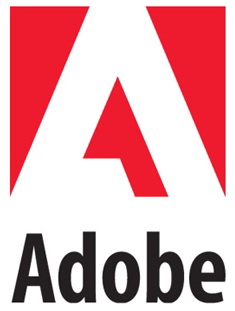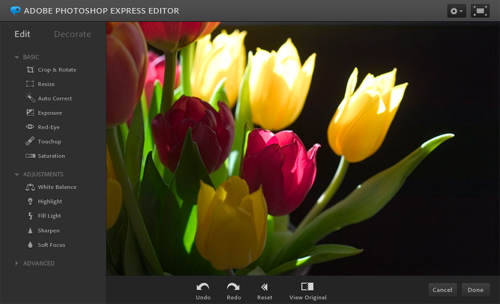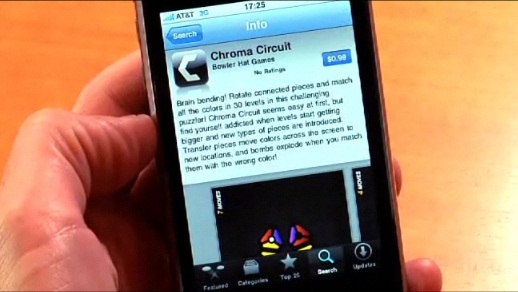
Adobe launches 'Square' Flash Player preview, adds IE9 & 64-bit OS support
Coinciding with Microsoft's launch of the Internet Explorer 9 beta, Adobe today rolled out a preview version of a new Flash Player it's calling "Square."
Because of the hot demand for a native 64-bit Flash Player, Square adds to the existent Linux 64-bit version by offering support for both Windows and Mac OS. Adobe says users of the previous 64-bit Flash Player for Linux will find this version to be faster and more reliable.

Adobe updates Web-based Photoshop, no longer demands membership
Now approaching its third year online, Adobe's Web-based photo editing suite Photoshop Express underwent a significant redesign which launched Wednesday. Adobe Photoshop Express Editor, Organizer, and Uploader are included in the refresh.
Firstly, a Photoshop.com account is no longer needed to use Photoshop Express Editor. Users can simply navigate to the Web app, upload photos directly from their local drive, edit and change the photos, and then save them back on their local storage. Previously, an account was necessary, and photos were uploaded to online storage first before they were edited. This is still an option, as Photoshop.com members can still store and share photos online as well as create albums, but it's no longer the only way to use the Editor.

Adobe lists Android devices that can expect Flash Player 10.1
Adobe began testing Flash Player 10.1 on Android 2.2 in late May, and hit the beta 3 phase last week.
Today, Adobe announced that the final version of Flash Player 10.1 has been sent to mobile platform partners, and that Flash Player 10.1 will be available as a final production release on the following "Froyo" (Android 2.2) devices:

Adobe Reader faces its first genuine competition from a free alternative
Download Nitro PDF Reader 1.1.1.13 from Fileforum now.
Even today, we tend to use the phrase "Adobe PDF" when referring to the Portable Document Format, despite the fact that Adobe released its ownership of the standard into the open community in 2008. The typical opinion has been that releasing PDF as ISO/IEC 32000-1 was more of a symbolic gesture, but that Acrobat would always remain the principal application for creating PDF files.

Google open-sources Web video codec; Mozilla, Opera, Adobe sign on
Wednesday afternoon, Google opted for the most daring option available to it: It is making available both the technology and the source code for the VP8 codec it acquired, in its buyout of On2 Technologies, to a separate entity. That entity, the newly formed WebM Project, will then serve as a licensing agent on Google's behalf for the VP8 video codec, the Vorbis audio codec, and the Matroska multimedia container, for royalty-free use, apparently in both free and commercial video.
At least as extraordinary, if not more so, is the new WebM group's list of charter supporters, which could be unofficially dubbed the "Everyone Except H.264 Coalition." Browser makers Mozilla and Opera both appear on this list, along with Adobe, the maker of Flash -- the Web's most prevalent distribution system for streaming video. And on the hardware side, both AMD (parent of ATI) and Nvidia have signed on, along with all the principal players in handheld components: ARM, Freescale, Marvell, TI, and Qualcomm.

Flash forward: Can Adobe leave Apple behind in the dust?
Flash, sharply rejected by Jobs and Company, has moved on to Apple's competitors, hoping for a warm welcome and the promise of a place in the mobile market. While Apple CEO Steve Jobs' recent open letter deploring Adobe's Flash managed to do little in terms of settling the argument as to who was right in the debate, it did point out many of the problems with the oft-buggy software that may indeed plague the smartphone experience.
With Flash Player 10.1 set to debut later this year and a slew of Flash alternatives moving into the forefront, the need for compatibility between third-party developers and designers has grown significantly. In 2009, Avi Greengart, the research director of consumer devices at Current Analysis, predicted that if Apple were to leave Flash out of its lineup, then it must be coming up with its own video support setup since it would end up being a disadvantage.

Adobe to Steve Jobs: 'We love you'
Yeah, but will Apple's CEO love Adobe back?
The Adobe-Apple breakup has taken on strange tabloid-like qualities over the last 30 days or so. Quick someone call in the paparazzi, but first ask if they'll be editing those photos in Adobe Photoshop, Photoshop Lightroom or Apple Aperture. Today, Adobe cofounders Chuck Geschke and John Warnock responded to Jobs' Aptil 29 "Thoughts on Flash" memo with their own: "Our thoughts on open markets." Adobe is supporting the memo with a marketing campaign -- "We love Apple" ads and "Freedom of Choice" Website." Adobe's response is measured and embracing, subtly placing the blame for the breakup on Apple. In the court of public and developer opinion -- perhaps shareholders in both companies -- Adobe may prove the venerable of the two parties here.

Adobe attempts to counteract anti-Flash sentiment spurred by Apple
Adobe is running quite a cleanup campaign after Apple CEO Steve Jobs' recent criticism of the Flash platform, which he laid out in a letter called "Thoughts on Flash."
Adobe has released a flurry of responses, including a letter from Chuck Geschke and John Warnock Adobe's Cofounders and Chairmen of the company's board of directors called "Our thoughts on open markets," an advertising campaign called "Freedom of Choice" which includes the banner shown above (and display ads that say "We [love] Apple,") an information page titled "The Truth about Flash," and a full-page ad in today's Washington Post.

Adobe gives up on Flash for iPhone and iPad, but leaves the door open
In an indirect yet obvious way, Section 3.3.1 of Apple's new iPhone developers' agreement binds developers to a promise that whatever they bring to the iPhone will be created exclusively for the iPhone. It effectively bans the use of cross-platform tools or middleware like Adobe Flash, by saying anything Apple approves must be coded in the company's own Objective-C, or in C or C++.
If Adobe were to have proceeded with its previous plans to forge an official, working Flash platform for iPhone, that would have been the defiant move. Instead, Mike Chambers, the company's product manager for Adobe Integrated Runtime (AIR), found himself yesterday afternoon sounding the retreat.

Adobe now taking beta testers for Flash Player 10.1 and AIR 2.0 for Android
Even if Apple CEO Steve Jobs says nobody will be using Adobe Flash in the future, and that the world is moving to HTML5, there's still a place for Adobe's browser plug-in on Android, the fastest growing mobile platform out there.
After putting Flash 10 on the HTC Hero last year, Adobe is ready to test the next iteration of Flash on all Android devices. Over the weekend, the company began accepting beta testers for the Android versions of Flash Player 10.1 and AIR 2.0.

Adobe's Creative Suite 5 packs in tons of new features
Adobe today celebrated the global launch of Creative Suite 5 (CS5), the first new version of the company's suite of digital art, design, and development tools in nearly two years.
Creative Suite 5 includes 15 of Adobe's products: Photoshop CS5, Illustrator CS5, InDesign CS5, Acrobat 9 Pro, Flash Catalyst CS5, Flash Professional CS5, Flash Builder 4, Dreamweaver CS5, Fireworks CS5, Contribute CS5, Adobe Premiere Pro CS5, After Effects CS5, Soundbooth CS5, Adobe OnLocation CS5, Adobe Bridge CS5, Adobe Device Central CS5, and Adobe Dynamic Link.

Crossing swords over cross-platform: Apple vs. Adobe Flash, C#, and Mono
It should come as no surprise to anyone that Apple is not a cross-platform tools company, nor a supporter of cross-platform technologies that would threaten to nullify Apple's baked-in advantages -- only during the years Steve Jobs was not in charge had the company even considered opening up its platforms. So the strategy behind the company's reinforcement of its iPhone OS 4.0 licensing terms, first discovered by Daring Fireball blogger John Gruber last Thursday, is both obvious and unchanged: to direct the course of iPhone/iPod Touch/iPad development traffic directly, exclusively, and entirely through Apple's channel.
States the newly added paragraph: "3.3.1 -- Applications may only use Documented APIs in the manner prescribed by Apple and must not use or call any private APIs. Applications must be originally written in Objective-C, C, C++, or JavaScript as executed by the iPhone OS WebKit engine, and only code written in C, C++, and Objective-C may compile and directly link against the Documented APIs (e.g., Applications that link to Documented APIs through an intermediary translation or compatibility layer or tool are prohibited)."
![An Acrobat.com workspace being shared. [Screenshot courtesy Adobe]](https://betanews.com/wp-content/uploads/media/47/4760.jpg)
Adobe tweaks the Web apps business model with paid collaboration
The puzzle for software companies as they adopt Web services is how to make them profitable. Anyone who tries the ad-supported model 1) plays against Google on its home turf; 2) risks working against application efficiency; 3) could raise the ire of users. And anyone who tries offering subscription to storage space 1) could easily be outdone by the first vendor to give away all its space for free; 2) faces an uphill value proposition against cheap local storage, and free synchronization such as Windows Live Sync solving the mobility problem.
Over the past several months, we've seen Adobe playing up collaboration as a key feature of its Acrobat.com service, even over portability -- the element that's most often associated with Adobe. Today, we have confirmation as to why: Inaugurating a potentially lucrative subscription strategy, Adobe hopes consumers will be willing to use Web apps such as Buzzword for free, while paying monthly for the capability to share documents.

Adobe to launch Creative Suite 5 April 12
A spokesperson for Adobe told Betanews this afternoon that on the morning of April 12 at 11:00 a.m. EDT, the company will hold a global online launch event for all of the components of its Creative Suite 5.
Among the most anticipated new components -- or as Adobe tends to present them in its periodic table, "elements" -- is a vastly improved HD video rendering engine called Mercury. Unlike other manufacturers, Adobe tends to retain the cool names for its products and platforms even after public release. Mercury will utilize the graphics processing power of video cards to expedite the decoding and playback of HD-encoded formats, especially for the Premiere Pro editor.

Adobe Reader 9.3 patch addresses critical JavaScript security issue
Download Adobe Reader 9.3 for Windows from Fileforum now.
Usually on a Patch Tuesday, the discussion turns to Microsoft; but amid a very light round of Windows fixes, it's Adobe in the spotlight today. Last month, a serious and potentially easily exploitable vulnerability was found in a JavaScript API call, DocMedia.NewPlayer -- a situation where an intentionally crafted PDF file could invoke the call, deallocate the memory allocated when the media player is generated, and then execute the code in that de-allocated memory, without need for privilege.
